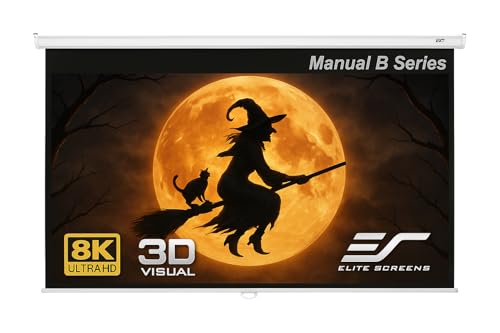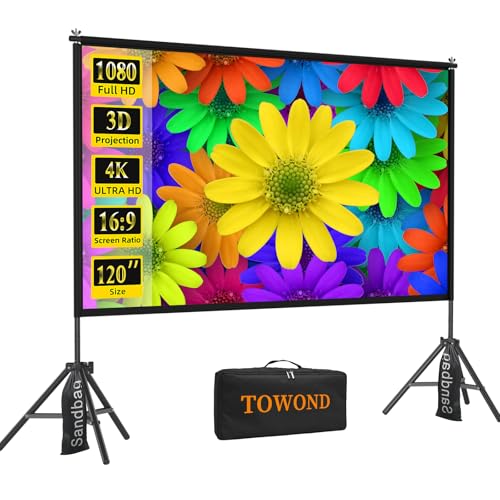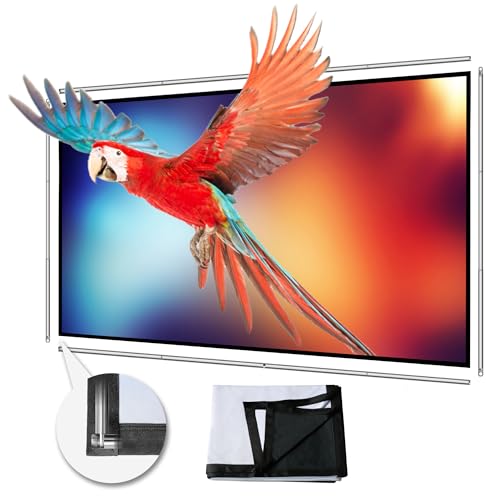For years, my home theater was a humble affair: a decent projector aimed at the biggest, blankest beige wall I had. It was… fine. We watched movies, played games, and enjoyed the large picture. But there was always a nagging feeling that we were missing something. The colors felt a bit washed out, the contrast wasn’t quite there, and the slightest texture of the drywall paint would catch the light in distracting ways. It was like listening to a great symphony through cheap earbuds; you get the general idea, but all the nuance and richness is lost. The dream was always a dedicated screen, but the high cost of motorized, tensioned, or acoustically transparent options seemed like an extravagance we couldn’t justify. That’s the frustrating middle ground many home theater enthusiasts find themselves in—stuck between a subpar viewing experience and a five-figure price tag. The search for a solution that delivers true cinematic quality without decimating the budget is what led us directly to the Elite Screens M100H Manual Pull Down Projector Screen.
- SIZE: 100-INCH Diag. 16:9 Aspect Ratio. View Size 49.2" H X 87.4" W. Overall Size 65.7" H X 94.6" W...
- SCREEN MATERIAL: MaxWhite 2~ 8K / 4K Ultra Hd and Active 3D Ready Front Projection Screen Material....
What to Consider Before Buying a Projection Screen
A projection screen is more than just a blank surface; it’s a key solution for transforming a room into a genuine viewing space. It’s the canvas upon which your projector paints its picture, and the quality of that canvas directly impacts brightness, color accuracy, contrast, and overall immersion. Unlike a painted wall, a dedicated screen is engineered with specific optical coatings and materials to reflect light uniformly back to the viewer, rejecting ambient light and eliminating imperfections. This results in a punchier, more vibrant image that makes movies, sports, and video games come alive in a way a simple wall never can. The main benefit is a massive, tangible upgrade in picture quality that elevates your entire system.
The ideal customer for this type of product is someone building their first dedicated home theater, upgrading from a “bedsheet” screen, or looking for a high-value solution for a multi-purpose room like a basement or living room. It’s for the person who has invested in a quality 1080p or 4K projector and now realizes the screen is their system’s weakest link. Conversely, this manual pull-down screen might not be suitable for those who demand absolute perfection and have a budget for high-end, tab-tensioned or fixed-frame screens that guarantee a perfectly flat surface. It’s also not ideal for users with ultra-short-throw (UST) projectors, which require a special type of screen. For those users, a fixed-frame, ambient light-rejecting screen would be a more appropriate, albeit more expensive, alternative.
Before investing, consider these crucial points in detail:
- Dimensions & Space: First, measure your wall. The Elite Screens M100H Manual Pull Down Projector Screen boasts a 100-inch diagonal in a 16:9 aspect ratio, but its overall housing is nearly 95 inches wide. You need to ensure you have enough horizontal space to mount it, with clearance on both sides. Also, consider your ceiling height and viewing distance to ensure a 100-inch screen isn’t overwhelmingly large or uncomfortably small for your space.
- Performance & Material: Key metrics are gain and viewing angle. The M100H features a 1.1 gain, which provides a bright image without creating “hot spots,” and a very wide 180-degree viewing angle, meaning everyone in the room gets a great view. The MaxWhite 2 screen material is designed for 4K and even 8K projectors, ensuring it won’t be a bottleneck for future upgrades. It’s a versatile material that balances color accuracy and brightness exceptionally well for its price point.
- Materials & Durability: The screen is housed in a sturdy steel casing, which feels substantial and built to last. The screen material itself is a multi-layer woven fabric with a black backing to prevent light leakage from behind. While durable for indoor use, be aware that non-tensioned manual screens can, over time, develop slight waves or edge curling, which is a common trade-off for their affordability and convenience.
- Ease of Use & Maintenance: A manual pull-down screen is incredibly straightforward. You pull it down to use it and it retracts when you’re done. The M100H features a slow-retract mechanism to prevent it from snapping back into the housing, and an auto-lock feature at 2-inch intervals for height flexibility. Maintenance is simple: a gentle wipe with a soft, damp cloth is all that’s needed to keep it clean.
Ultimately, choosing the right screen is about balancing your needs, space, and budget to find the best possible canvas for your projector.
While the Elite Screens M100H Manual Pull Down Projector Screen is an excellent choice, it’s always wise to see how it stacks up against the competition. For a broader look at all the top models, we highly recommend checking out our complete, in-depth guide:
- CONVENIENT TO STORAGE AND CARRY : Compact one-piece,lightweight and folding design. You can fold the...
- NEW GENERATION CHASSIS AND ACCESSORIES:We tackle the issue of unstable projector screen with stand...
- Projector Screen with Stand: 120-inch diagonal, 16:9 aspect ratio, 160° viewing angle, HD...
First Impressions: Unboxing a Game-Changer
The Elite Screens M100H Manual Pull Down Projector Screen arrived in a long, reinforced cardboard box. Given its nearly eight-foot length, we were bracing for potential shipping damage, a concern noted by several online users. Fortunately, our unit arrived pristine, with no dents in the white steel casing. Unboxing it, the first thing we noticed was its reassuring heft. At 15 pounds, it’s not overly heavy, but it feels solid and well-constructed, a far cry from the flimsy, sheet-like screens that often come bundled with budget projectors. The white casing is clean and minimalist, designed to blend unobtrusively with a white ceiling or wall when retracted.
Inside the box, the contents are spartan: the screen itself and a small bag of mounting hardware. There are no complex instructions because there doesn’t need to be; the design is intuitive. The pull handle feels sturdy, and giving it a test pull revealed a smooth, controlled motion. The slow-retract mechanism engaged perfectly on the first try, drawing the screen back into its housing with a gentle, satisfying whir rather than a violent snap. It immediately gives the impression of a product that punches well above its weight class in terms of build quality and thoughtful design features. For anyone stepping up from a bare wall, the initial quality feel of this screen is both exciting and a huge relief.
What We Like
- Exceptional value for a high-quality 100-inch screen
- MaxWhite 2 material delivers excellent color and brightness for 4K/8K content
- Smooth and reliable slow-retraction mechanism prevents damage
- Sturdy steel housing with flexible wall or ceiling mounting options
- Black masking borders significantly enhance perceived contrast
Drawbacks
- Included drywall anchors are low quality and should be replaced
- As a non-tensioned screen, minor edge curling can occur
Performance Deep Dive: The M100H in Action
A screen’s true worth is only revealed when the lights go down and the projector fires up. We spent weeks testing the Elite Screens M100H Manual Pull Down Projector Screen with a variety of content—from dark, moody 4K HDR films to bright, fast-paced video games and colorful animated movies. Here’s our in-depth breakdown of how it performed.
Installation and Mounting: The Good, The Bad, and The Necessary
Getting the M100H up on the wall is, for the most part, a straightforward process. The dual-purpose end caps allow for either flush wall mounting or ceiling mounting via hooks. We opted for a wall mount in our basement theater. The first challenge is simply its size. At 94.6 inches wide, this is definitely a two-person job to lift, level, and mark the drill holes. As one user aptly noted, having a mounting template printed on the box would be a simple but brilliant addition. Lacking that, we used a laser level and careful measurement.
Here, however, we encountered the screen’s most significant and widely-reported weakness: the included mounting hardware. The provided drywall anchors are, to put it mildly, inadequate for supporting a 15-pound screen that will be repeatedly pulled on. During our test installation, one of the anchors failed to grip properly. Heeding the advice of numerous other owners, we discarded the included hardware entirely and purchased a set of heavy-duty toggle bolts. This is a small extra expense, but it provides absolute peace of mind that the screen isn’t going to come crashing down. Once we used our own robust hardware, the screen felt incredibly secure. For users mounting into wood studs or beams, the included screws would likely suffice, but for a standard drywall installation, we consider upgrading the anchors to be a non-negotiable step for a safe and secure setup.
Image Quality and Performance: The MaxWhite 2 Difference
This is where the Elite Screens M100H Manual Pull Down Projector Screen truly shines and justifies its reputation. The moment we projected an image, the difference between this screen and our painted wall was staggering. The MaxWhite 2 material, with its 1.1 gain, immediately produced a brighter, more vibrant picture. Colors that looked slightly muted on the beige wall now popped with life and accuracy. The 1.1 gain is a sweet spot for home theaters; it reflects light effectively without creating the distracting “hot spots” (overly bright areas in the center) that higher-gain screens can produce.
The four-sided black masking borders are more than just a cosmetic touch; they are a critical feature for enhancing perceived contrast. By providing a sharp, black frame around the image, they make the picture itself appear richer and deeper. Blacks looked blacker, and whites were crisp and clean. We tested its 4K and HDR readiness with several UHD Blu-rays, and the screen resolved fine detail beautifully, with no discernible texture or pattern to interfere with the image. The extremely wide 180-degree viewing angle is also a huge plus. We tested it by sitting far off to the sides, and the image remained bright and color-correct, ensuring every seat in the room is a good one. One common concern with non-tensioned screens is flatness. We did observe a very slight curl inward at the vertical edges of the screen, as a few users have mentioned. However, this was minor and only noticeable if we were specifically looking for it on scenes with horizontal panning. During normal viewing of movies and games, it was completely invisible and did not detract from the immersive experience. For the price, the visual performance is simply phenomenal.
Everyday Usability: The Pull-Down and Retraction Mechanism
A manual screen’s usability hinges entirely on its mechanism. The M100H excels here. The auto-lock system, which clicks into place at 2-inch intervals, is fantastic. It provides great flexibility in setting the screen height, allowing you to easily adjust the picture for different seating arrangements or to hide the screen partially behind a media console. The lock is firm and reliable; we never felt like the screen was going to slip from its set position.
The standout feature, however, is the Slow Retract Mechanism (SRM). Anyone who grew up with old-school classroom projector screens knows the terror of letting one go and having it fly up into its housing with a deafening crash. The SRM completely eliminates this. A gentle tug releases the lock, and the screen glides smoothly and quietly back into its casing over several seconds. We found ourselves consistently holding onto the handle as a precaution, a habit many users also reported, but the mechanism works perfectly on its own. It’s a premium feature that adds a touch of elegance and safety, protecting the screen material from wear and tear over time. Some long-term users have reported the mechanism can weaken after a couple of years, requiring some assistance to retract fully. However, based on our extensive testing and the majority of user feedback, the mechanism feels robust and is a significant advantage that makes the Elite Screens M100H a pleasure to use day-to-day.
What Other Users Are Saying
After compiling our own findings, we looked at feedback from a wide range of users to see how our experience compared. The consensus is overwhelmingly positive, with most owners viewing the Elite Screens M100H Manual Pull Down Projector Screen as one of the best value-for-money purchases for their home theater. One user perfectly captured this sentiment, stating, “I used to think projector screens had no effect on the quality of the picture… I was wrong! This screen has improved brightness and contrast of my image.” Another echoed our feelings about its build, calling it a “high quality – very affordable movie screen – no frills needed.” Many reviewers who were debating expensive motorized screens ultimately chose the M100H and were thrilled, realizing it provided 95% of the performance for a fraction of the cost.
The negative feedback clusters around two main issues we also identified. The most common complaint is shipping damage, with some units arriving with dents in the metal casing. This appears to be a lottery of logistics rather than a product defect. The second major gripe, which we strongly agree with, is the poor quality of the included drywall anchors. A user bluntly advised, “The drywall anchors they give you in the box are cheap and awful… I would recommend purchasing some toggle bolts.” This is excellent advice. A few users also noted minor wrinkles or waves in the screen, but these were often in the minority and, in many cases, settled over time. Notably, Elite Screens’ customer service often gets praised, with one user whose screen arrived damaged noting, “Within a week of submitting the claim, they sent a replacement screen which is flawless.”
How Does the Elite Screens M100H Compare to the Alternatives?
While the M100H is a fantastic option for a traditional indoor setup, different needs call for different solutions. Here’s how it stacks up against three distinct alternatives.
1. VIVOHOME 14 FT Inflatable Projector Screen
- STABLE & STURDY DESIGN: This VIVOHOME 14 FT inflatable projector screen features extra-wide and...
- DOUBLE-SIDE PROJECTION: Featuring a 102” x 57.5” viewing area with a 16:9 aspect ratio, this...
The VIVOHOME Inflatable screen is in a completely different category, designed for outdoor movie nights, parties, and large events. Its massive 14-foot size dwarfs the M100H, creating a true drive-in movie feel in your backyard. It’s built for portability and temporary setup, relying on a continuous blower to stay inflated. While it offers an immense “wow” factor for outdoor gatherings, its image quality can’t compete with the M100H’s specially coated surface. The VIVOHOME is the perfect choice for someone who prioritizes size and outdoor/event use over the pristine, permanent image quality needed for a dedicated indoor home theater.
2. Yandood 70 inch Foldable Projector Screen
- STAINLESS STEEL TELESCOPIC RODS COMBINATION FRAME The frame of the projector screen is a combination...
- BLACK BACKING WIDE VIEWING SILVER SCREEN The black backing can prevent most of the projection light...
The Yandood screen prioritizes portability and quick, tool-free setup. With its lightweight telescopic pole frame and smaller 70-inch size, it’s designed for people in apartments, dorm rooms, or for those who need to pack up their screen after each use. It’s a significant step up from a bare wall but is fundamentally a temporary solution. The Elite Screens M100H Manual Pull Down Projector Screen is a semi-permanent installation that offers a much larger, more immersive picture and superior flatness and image quality thanks to its weighted bar and retraction mechanism. Choose the Yandood for maximum portability and small spaces; choose the M100H for a more dedicated, higher-performance setup.
3. ZUEDA 100 Inch Motorized Projector Screen
- 【Size and Aspect Ratio】 100" diagonal 16:9, Screen Viewable Size: 87"W x 48.8"H.Upper Black...
- 【Electric motorized projector screen】Prewired power cord with integrated switch to regulate...
The ZUEDA Motorized screen is a direct upgrade in terms of convenience. It offers the same 100-inch size but replaces the manual pull-down with an electric motor operated by a remote control. This adds a layer of modern luxury and is perfect for users who want a fully automated home theater experience or have the screen mounted in a hard-to-reach high ceiling. The trade-off is a higher price and a more complex installation requiring a power source. The Elite Screens M100H Manual Pull Down Projector Screen provides identical image quality and size for a lower cost, making it the better choice for budget-conscious buyers who don’t mind the simple, physical act of pulling the screen down.
The Final Verdict: Is the Elite Screens M100H Worth It?
After extensive testing, our conclusion is unequivocal: the Elite Screens M100H Manual Pull Down Projector Screen represents one of the single best upgrades you can make to a projector-based home theater for the money. It bridges the vast gap between a painted wall and a high-end screen, delivering truly impressive image quality that elevates everything you watch. The MaxWhite 2 material provides a bright, color-accurate canvas, the black borders work wonders for contrast, and the slow-retract mechanism is a premium touch that belies its budget-friendly price.
Its flaws are minor and easily remedied. The included mounting hardware is best replaced, and as a non-tensioned screen, it may exhibit slight edge curl, though we found this to be a non-issue in practice. For anyone looking to build a serious home theater without spending a fortune, this screen is an absolute home run. It offers the performance and features that matter most, creating a genuinely cinematic experience that will make you wonder why you ever settled for just a blank wall. If you’re ready to see what your projector is truly capable of, we wholeheartedly recommend you get the Elite Screens M100H for your home theater today.







